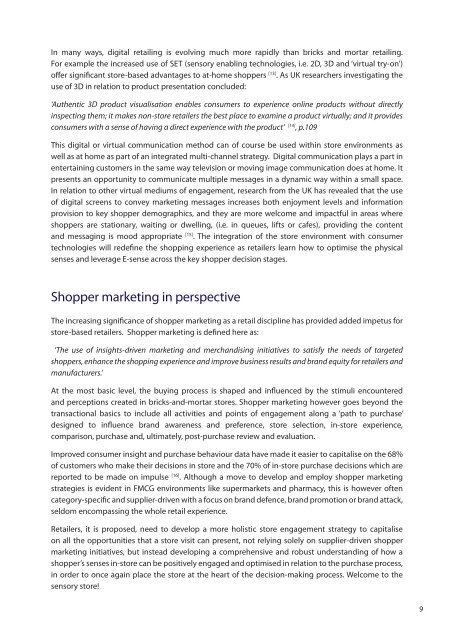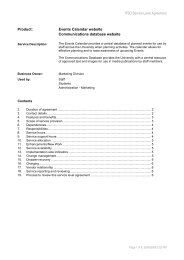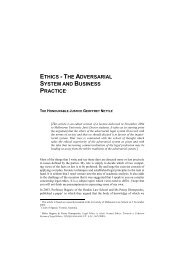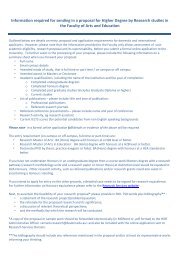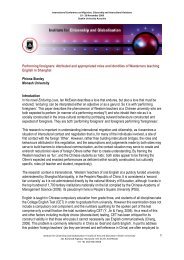Store sense: Reclaiming the four walls with - Deakin University
Store sense: Reclaiming the four walls with - Deakin University
Store sense: Reclaiming the four walls with - Deakin University
Create successful ePaper yourself
Turn your PDF publications into a flip-book with our unique Google optimized e-Paper software.
In many ways, digital retailing is evolving much more rapidly than bricks and mortar retailing.<br />
For example <strong>the</strong> increased use of SET (sensory enabling technologies, i.e. 2D, 3D and ‘virtual try-on’)<br />
offer significant store-based advantages to at-home shoppers [13] . As UK researchers investigating <strong>the</strong><br />
use of 3D in relation to product presentation concluded:<br />
‘Au<strong>the</strong>ntic 3D product visualisation enables consumers to experience online products <strong>with</strong>out directly<br />
inspecting <strong>the</strong>m; it makes non-store retailers <strong>the</strong> best place to examine a product virtually; and it provides<br />
consumers <strong>with</strong> a <strong>sense</strong> of having a direct experience <strong>with</strong> <strong>the</strong> product’ [14] , p.109<br />
This digital or virtual communication method can of course be used <strong>with</strong>in store environments as<br />
well as at home as part of an integrated multi-channel strategy. Digital communication plays a part in<br />
entertaining customers in <strong>the</strong> same way television or moving image communication does at home. It<br />
presents an opportunity to communicate multiple messages in a dynamic way <strong>with</strong>in a small space.<br />
In relation to o<strong>the</strong>r virtual mediums of engagement, research from <strong>the</strong> UK has revealed that <strong>the</strong> use<br />
of digital screens to convey marketing messages increases both enjoyment levels and information<br />
provision to key shopper demographics, and <strong>the</strong>y are more welcome and impactful in areas where<br />
shoppers are stationary, waiting or dwelling, (i.e. in queues, lifts or cafes), providing <strong>the</strong> content<br />
and messaging is mood appropriate [15] . The integration of <strong>the</strong> store environment <strong>with</strong> consumer<br />
technologies will redefine <strong>the</strong> shopping experience as retailers learn how to optimise <strong>the</strong> physical<br />
<strong>sense</strong>s and leverage E-<strong>sense</strong> across <strong>the</strong> key shopper decision stages.<br />
Shopper marketing in perspective<br />
The increasing significance of shopper marketing as a retail discipline has provided added impetus for<br />
store-based retailers. Shopper marketing is defined here as:<br />
‘The use of insights-driven marketing and merchandising initiatives to satisfy <strong>the</strong> needs of targeted<br />
shoppers, enhance <strong>the</strong> shopping experience and improve business results and brand equity for retailers and<br />
manufacturers.’<br />
At <strong>the</strong> most basic level, <strong>the</strong> buying process is shaped and influenced by <strong>the</strong> stimuli encountered<br />
and perceptions created in bricks-and-mortar stores. Shopper marketing however goes beyond <strong>the</strong><br />
transactional basics to include all activities and points of engagement along a ‘path to purchase’<br />
designed to influence brand awareness and preference, store selection, in-store experience,<br />
comparison, purchase and, ultimately, post-purchase review and evaluation.<br />
Improved consumer insight and purchase behaviour data have made it easier to capitalise on <strong>the</strong> 68%<br />
of customers who make <strong>the</strong>ir decisions in store and <strong>the</strong> 70% of in-store purchase decisions which are<br />
reported to be made on impulse [16] . Although a move to develop and employ shopper marketing<br />
strategies is evident in FMCG environments like supermarkets and pharmacy, this is however often<br />
category-specific and supplier-driven <strong>with</strong> a focus on brand defence, brand promotion or brand attack,<br />
seldom encompassing <strong>the</strong> whole retail experience.<br />
Retailers, it is proposed, need to develop a more holistic store engagement strategy to capitalise<br />
on all <strong>the</strong> opportunities that a store visit can present, not relying solely on supplier-driven shopper<br />
marketing initiatives, but instead developing a comprehensive and robust understanding of how a<br />
shopper’s <strong>sense</strong>s in-store can be positively engaged and optimised in relation to <strong>the</strong> purchase process,<br />
in order to once again place <strong>the</strong> store at <strong>the</strong> heart of <strong>the</strong> decision-making process. Welcome to <strong>the</strong><br />
sensory store!<br />
9


